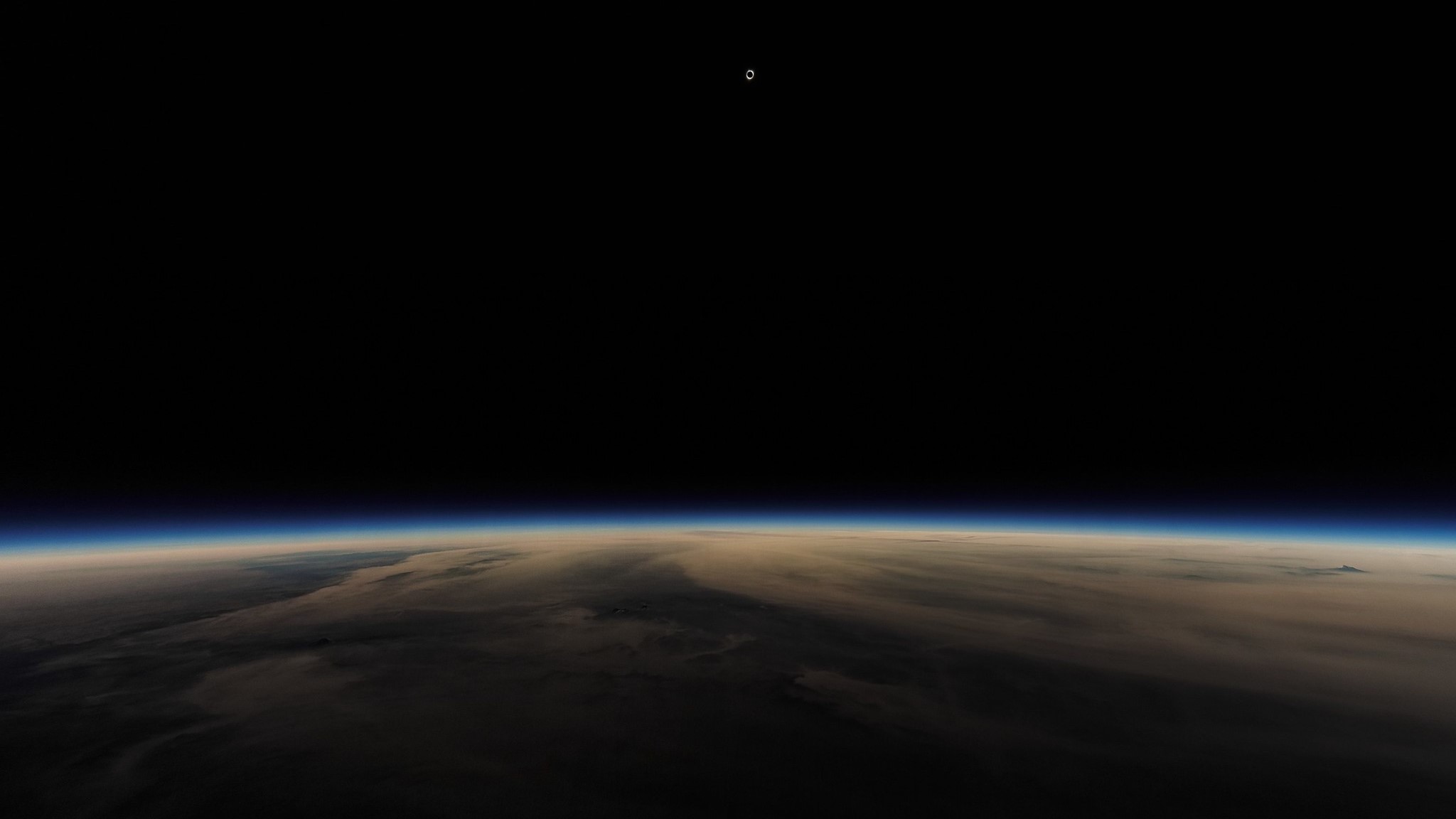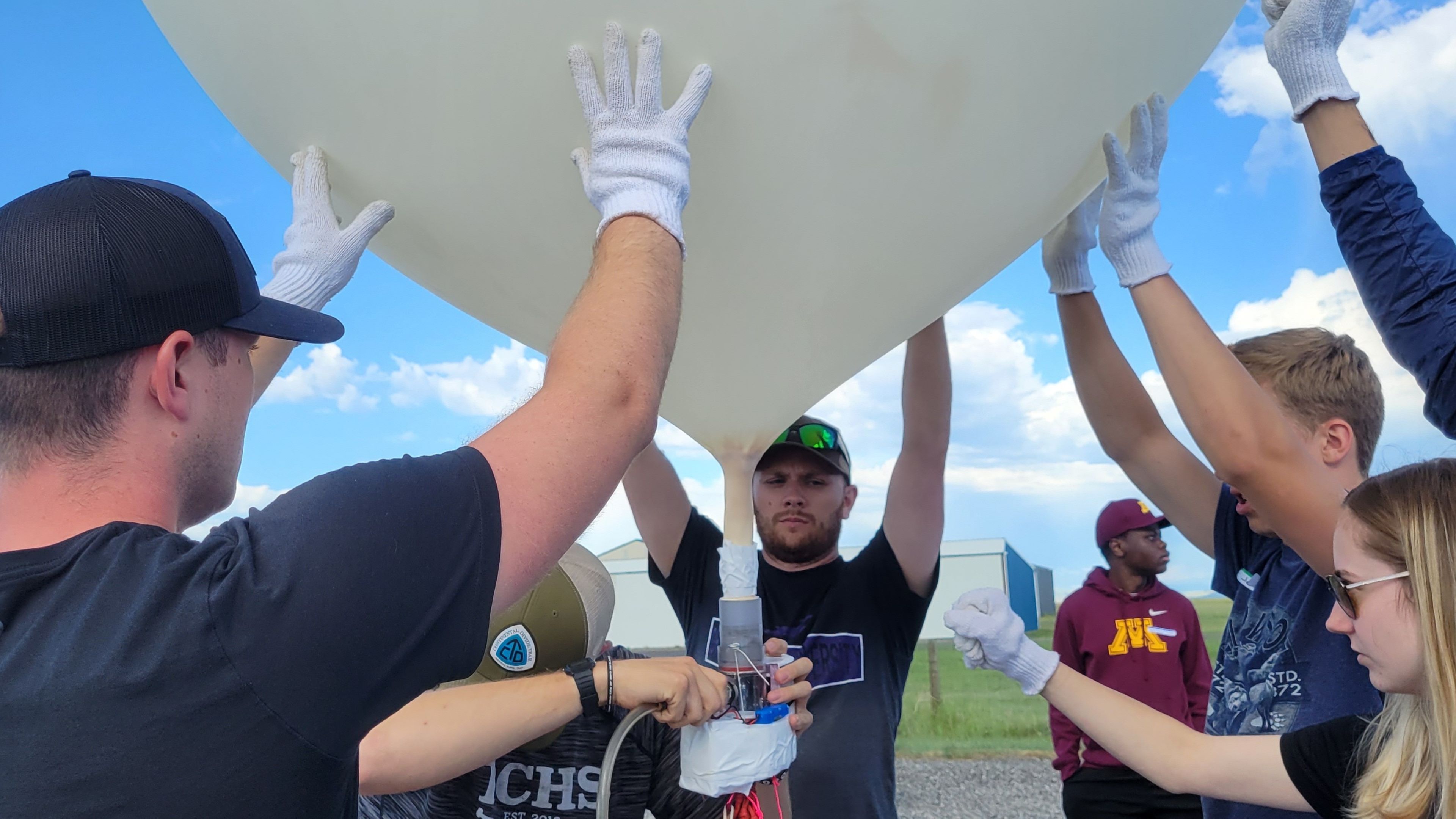Don't panic if you see balloons hovering during America's two upcoming solar eclipses
It's probably just the National Eclipse Ballooning Project (NEBP) livestreaming and doing science above 99.5% of the atmosphere.

During the morning on Saturday, Oct. 14 over 1,000 balloons will float 20 miles (32 kilometers) up in the stratosphere over Oregon, Nevada, Utah, New Mexico and Texas just as a solar eclipse sweeps across the U.S Southwest.
Not to be confused with the 200-foot balloon shot down off the coast of the US in February — an alleged spying attempt by China — these small helium balloons carrying 12 lbs/5.4kg payload will all have clearance from the FAA.
The Nationwide Eclipse Ballooning Project is an attempt to take advantage of both the October 14, 2023 annular solar eclipse and April 8, 2024 total solar eclipse. Some balloons will livestream video from the stratosphere — 100,000 feet up — to the NASA eclipse website using Insta360 (and other) cameras while others will monitor for changes in the atmosphere at 115,000 feet.
Related: What's the difference between a total solar eclipse and an annular solar eclipse?
February's incident could have put a spanner into the works of one of the biggest science experiments organized for the annular solar eclipse, during which up to 91% of the sun will be blocked from a 125-mile path through nine U.S. states. "We didn't panic, but we were definitely a little worried and wondered how it might affect us," Angela Des Jardins, a physicist at Montana State University and leader of the Nationwide Eclipse Ballooning Project, told Space.com. "There's now an increased need to make sure that the authorities know what's going on, including local law enforcement."
Although the balloons will reach far above the cruising altitude for commercial airliners, their flight patterns have to be figured out and avoided. Major airports, national parks and military installations can't be flown over. The Federal Aviation Administration will know exactly where the balloons are at all times. "Technically we'll fly under the limit where you don't have to contact the FAA, but because there's going to be a lot going on in the air our teams are going to be communicating with them," says Des Jardins.
The 53 teams, split into nine pods, comprise around 750 STEM students from across the U.S. "I'm excited about the science, but one of the really amazing things about this project is just what the students will get out of it," says Des Jardins. "It's dominating their academic lives for the 18 months that they're participating."
Breaking space news, the latest updates on rocket launches, skywatching events and more!
Livestreaming the eclipses from balloons
The project builds on NASA and NSF-sponsored Nationwide Eclipse Ballooning Project, which in 2017 saw 55 teams attempt to broadcast incredible 360º views of the Earth from above during totality. Although some great views were obtained and livestreamed, some teams failed. After all, back in 2017, the age of livestreaming was in its infancy. "There were some unfortunate stories from teams where internet access was good until huge crowds of people appeared," says Des Jardins. "We were really pushing the bounds on the technology back then when YouTube Live was just becoming a thing — it was technically very challenging."
The cameras — on 34 balloons — are primarily there to capture Earth from above during the eclipse, though images of the eclipsed sun will be captured in April. The cameras aren't fitted with solar filters, so in October will provide views of Earth during the 'ring of fire' — and perhaps showcase some atmospheric effects. "NASA will have three different broadcast locations for October so as the eclipse moves across the production crew will switch between those locations and use our feeds as they need," says Des Jardins.
Studying the boundary layer
It's also hoped — primarily during April's total solar eclipse — that 19 science teams, each flying 30 balloons will capture changes in Earth's atmosphere caused by the sudden decrease in sunlight.
In an expansion of an experiment performed by six teams in 2017, they'll study what happens to the boundary layer, part of the atmosphere that's affected directly by Earth's surface. Its depth changes every day and night. "It goes up in the day when it's hot and it comes down almost to the ground during the night," says Des Jardins. It's expected that during an eclipse the boundary layer is going to fall.
During both eclipses, the atmospheric science teams will have ground weather stations to take measurements, with the balloons collecting temperature data in the different layers of the atmosphere. The balloons will also be fitted with standard sensors called a radiosonde, each weighing 0.4 lbs/190g, that measures temperature, pressure, wind direction and wind speed — the kind of which are simultaneously flown to about 100,000 feet twice a day, every day from 92 different stations across the U.S. and almost 900 locations worldwide, according to the National Weather Service.
The search for waves
There's also a hope that gravity waves can be captured. Not to be confused with gravitational waves, gravity waves are a wave moving through a stable layer of the atmosphere, according to the National Weather Service. They're caused by air being vertically displaced — typically by a mountain or a thunderstorm updraft — and they create a rippled pattern in high clouds, if there are any.
Three gravity waves were detected by one of the project's science balloon teams at a total solar eclipse in Chile in 2019, but this time it's hoped that images will also be captured. "The conditions have to be just right," says Des Jardins, who is hoping for something most eclipse-chasers will be keen to avoid. "We need a little bit of higher level cloud, but if we get that then there's definitely a chance that we'll be able to see gravity waves from the balloons with the cameras while the atmospheric science balloons collect the detailed data."
Even if there are no clouds — so no visual evidence — from the data on temperature, pressure, wind direction and wind speed it will be possible to to deduce the pressure waves and where the gravity waves were.
How the balloons work
The way a helium-filled latex weather balloon works is pretty simple. "As it goes up the relative pressure difference causes the balloon to expand, it pops and then it comes back down," says Des Jardins. The payload floats back down by parachute.
However, this time a new kind of balloon will be used that has a vent so the teams will be able to let some helium out when they reach about 70,000 feet. That will enable the balloons to float when they reach around 90,000 feet. "The idea is that if there's a gravity wave generated by the eclipse we'll be able to see it in the motion of the balloon as it bobs along it," says Des Jardins. "We'll float them during the eclipses, and a little bit after, so we can get precise GPS data got the gravity wave." This new design will also mean the balloons are as stable as possible, which should improve the footage and images.
The way the equipment is retrieved has also had to be tweaked. In 2017 many of the cameras and payloads ended up in the high branches of trees. "Many of them took a week to get out of trees," says Des Jardins. "This time we've purchased a tree pole for all the teams!"
Although it's April's total solar eclipse — the last to cross the U.S. until 2045 — that's the real prize, October's annular provides an incredibly rare opportunity for a practice run. It's also a unique chance to compare and contrast what happens during two different kinds of eclipses, one with a deep moon shadow and one where a large portion of the sun is obscured. "Nature has handed us a wonderful set of eclipses six months apart, in our own country," says Des Jardins. "It's such a great opportunity to observe what's going on in the atmosphere during both types of eclipse."

Jamie is an experienced science, technology and travel journalist and stargazer who writes about exploring the night sky, solar and lunar eclipses, moon-gazing, astro-travel, astronomy and space exploration. He is the editor of WhenIsTheNextEclipse.com and author of A Stargazing Program For Beginners, and is a senior contributor at Forbes. His special skill is turning tech-babble into plain English.



